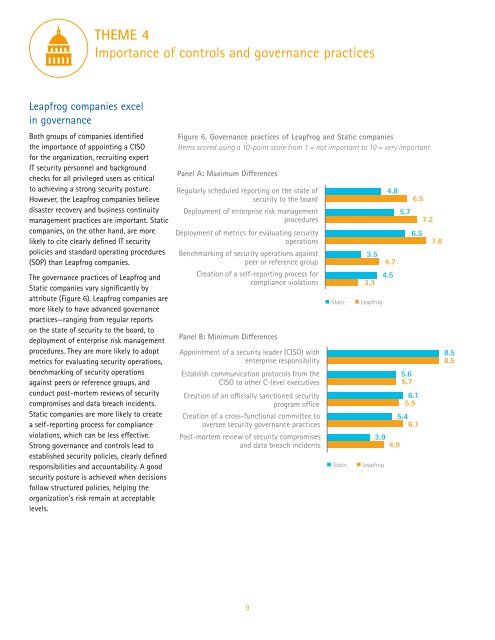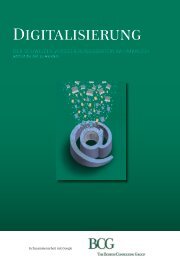Accenture-Cyber-Security-Leap-2015-Report
Accenture-Cyber-Security-Leap-2015-Report
Accenture-Cyber-Security-Leap-2015-Report
You also want an ePaper? Increase the reach of your titles
YUMPU automatically turns print PDFs into web optimized ePapers that Google loves.
THEME 4<br />
Importance of controls and governance practices<br />
<strong>Leap</strong>frog companies excel<br />
in governance<br />
Both groups of companies identified<br />
the importance of appointing a CISO<br />
for the organization, recruiting expert<br />
IT security personnel and background<br />
checks for all privileged users as critical<br />
to achieving a strong security posture.<br />
However, the <strong>Leap</strong>frog companies believe<br />
disaster recovery and business continuity<br />
management practices are important. Static<br />
companies, on the other hand, are more<br />
likely to cite clearly defined IT security<br />
policies and standard operating procedures<br />
(SOP) than <strong>Leap</strong>frog companies.<br />
The governance practices of <strong>Leap</strong>frog and<br />
Static companies vary significantly by<br />
attribute (Figure 6). <strong>Leap</strong>frog companies are<br />
more likely to have advanced governance<br />
practices—ranging from regular reports<br />
on the state of security to the board, to<br />
deployment of enterprise risk management<br />
procedures. They are more likely to adopt<br />
metrics for evaluating security operations,<br />
benchmarking of security operations<br />
against peers or reference groups, and<br />
conduct post-mortem reviews of security<br />
compromises and data breach incidents.<br />
Static companies are more likely to create<br />
a self-reporting process for compliance<br />
violations, which can be less effective.<br />
Strong governance and controls lead to<br />
established security policies, clearly defined<br />
responsibilities and accountability. A good<br />
security posture is achieved when decisions<br />
follow structured policies, helping the<br />
organization’s risk remain at acceptable<br />
levels.<br />
Figure 6. Governance practices of <strong>Leap</strong>frog and Static companies<br />
Items scored using a 10-point scale from 1 = not important to 10 = very important<br />
Panel A: Maximum Differences<br />
Regularly scheduled reporting on the state of<br />
security to the board<br />
Deployment of enterprise risk management<br />
procedures<br />
Deployment of metrics for evaluating security<br />
operations<br />
Benchmarking of security operations against<br />
peer or reference group<br />
Creation of a self-reporting process for<br />
compliance violations<br />
Panel B: Minimum Differences<br />
Appointment of a security leader (CISO) with<br />
enterprise responsibility<br />
Establish communication protocols from the<br />
CISO to other C-level executives<br />
Creation of an officially sanctioned security<br />
program office<br />
Creation of a cross-functional committee to<br />
oversee security governance practices<br />
Post-mortem review of security compromises<br />
and data breach incidents<br />
Static<br />
Static<br />
3.5<br />
4.7<br />
4.5<br />
3.3<br />
<strong>Leap</strong>frog<br />
4.8<br />
6.5<br />
5.7<br />
7.2<br />
6.5<br />
5.6<br />
5.7<br />
6.1<br />
5.9<br />
5.4<br />
6.1<br />
3.9<br />
4.9<br />
<strong>Leap</strong>frog<br />
7.8<br />
8.5<br />
8.5<br />
9



